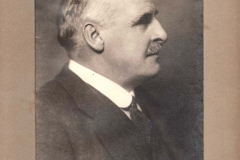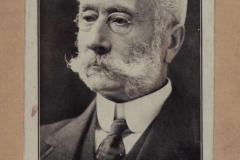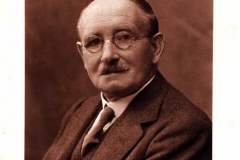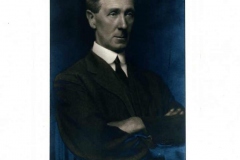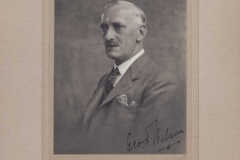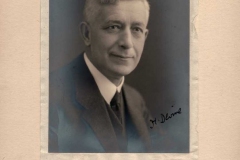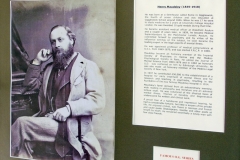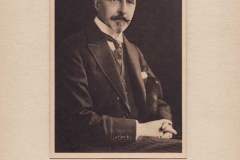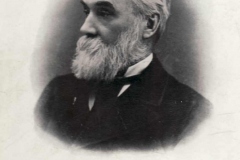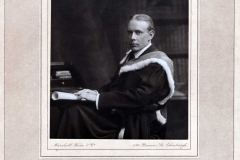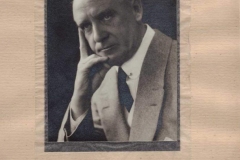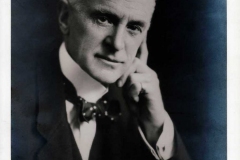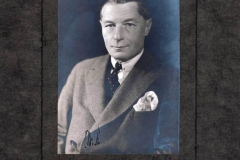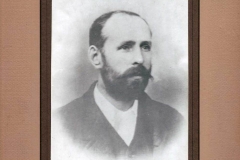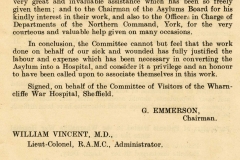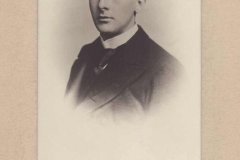Pictured in this section are just some of the eminent Medical men who at one time or another spent time at Stanley Royd Hospital.
FERRIER, Sir David (1843-1928)
Sir David Ferrier was born on 13 January 1843 at Woodside, near Aberdeen, the son of David Ferrier, businessman. He was educated at the local grammar school before entering Aberdeen University in 1859. He graduated MA in 1863 with first class honours in classics and philosophy, and then spent the next six months in Europe. Whilst abroad he spent some time studying psychology at Heidelberg. In 1865 he went to Edinburgh University to study medicine, graduating MB in 1868.
From 1868-70 Ferrier was assistant to a general practitioner, William Edmund Image, in Bury St Edmunds, Suffolk. During this time Ferrier prepared his MD thesis on corpora quadrigemina, for which he was awarded a gold medal. In 1870 he moved to London and was lecturer on physiology at the Middlesex Hospital for a short time. The following year he was appointed demonstrator of physiology at King’s College Hospital, and in 1872 succeeded to the chair of forensic medicine.
In 1873 Ferrier began his research into electrical excitation of the brain. He proved through his experiments the existence of the localization of the cerebral functions, a fact hitherto disputed. Indeed he was the first to map the cerebral cortex, from what had been an unknown area. Ferrier demonstrated that the combined areas of excitable points on the brain’s surface were more extensive, and that more movements throughout the body could be elicited, in an ape than in animals less like human beings. He further inferred, through his research on monkeys, that conditions of disease in the brain could be effectively dealt with surgically, to a far greater extent than had been done previously.
Ferrier undoubtedly made a great contribution to modern cerebral surgery, enabling relief for patients suffering from certain forms of brain tumour and brain injury, although his animal experiments brought him opposition from anti-vivisectionists. His Croonian Lectures to the Royal Society in 1874 and 1875 were on the subject of his early research, as was his treatise, The Functions of the Brain (1876; 2nd ed. 1886), which was translated into several languages.
In 1874 he was elected assistant physician both at King’s College Hospital and at the West London Hospital. He was elected fellow of the Royal Society in 1876. In the following year he also became a fellow of the Royal College of Physicians, and in 1878 delivered the College’s Goulstonian Lectures on the subject of localization of cerebral disease. Ferrier was an active member of the Neurological Society, and was one of the founders and editors of the journal Brain when it started in 1878. In 1881 he became physician in charge of outpatients at King’s College Hospital. At this time he was also on the staff at the National Hospital for the Paralysed and Epileptic.
Ferrier was a member of the Metropolitan Counties Branch of the British Medical Association from 1888-89. In 1889 the post of Professor of Neuropathology was created for him at King’s College London. The following year he was made full physician at King’s College Hospital. Also in 1890 he was awarded the Royal Medal of the Royal Society, and in 1891 the Cameron Prize of Edinburgh University. In 1894 he was president of the Neurological Society, having been a member of the council of the society for a number of years. At the Royal College of Physicians he delivered the Harveian Oration in 1902, and acted as senior censor in 1907. In 1908 he was appointed emeritus professor at King’s College London.
Ferrier was knighted in 1911. In 1913 he was president of the Medical Society of London. He was awarded honorary degrees from the universities of Cambridge and Birmingham.
Ferrier had married Constance Waterlow in 1874, and they had a son and a daughter. Ferrier died in London on 19 March 1928 at his home in Kensington. An eponymous lecture was posthumously endowed at the Royal Society in 1929, and at the Royal Society of Medicine a Ferrier memorial library was founded and endowed.
Publications
Historical Notes on Poisoning (London, 1872)
The Localisation of Cerebral Disease (Goulstonian Lectures, 1878) (London, 1878)
The Functions of the Brain (London, 1876; 2nd ed. 1886)
Principles of Forensic Medicine, William Augustus and David
Ferrier (London, 6th ed. 1888)
Cerebral Localisation (London, 1890)
The Heart and Nervous System (Harveian Oration, 1902) (London, 1902)
On Tabes Dorsalis (Lumleian Lectures, 1906) (London, 1906)
………………………………………………………………………………………
Charles Hubert Bond MB (Edinburgh 1892), BSc (Edinburgh 1893) CBE (1920) KBE (1929)
Commissioner 1912-1945
Born 6.9.1870 Died 18.4.1945
Born at Ogbourne St George, Wiltshire. (Spelt Agbourne 1901 Census) The elder son of Rev Alfred Bond who became chaplain to Worcester County Asylum, Powick.
1881 Aged ten: living at Powick where Edward Marriot Cooke became asylum superintendent later that year.
1892 MB (Edinburgh)
1893 B.Sc (Public Health) (Edinburgh)
Junior appointment Morningside Asylum, Edinburgh.
Subsequent posts at Wakefield, Banstead and Bexley
1900 Married Janet Constance Laurie (born about 1873), daughter of Frederic Robert Laurie (born about 1842) and Mary H. Laurie (born about 1845) of Worcester. Janet was the daughter of a Worcester Bank Manager (see 1881 census). They had one daughter.
Reginald Bond (1872-1955), Charles younger brother, shown as a surgeon in the 1901 census. He became medical director-general of the Royal Navy. Charles Bond was “for many years… consultant in neurology and mental disorders to the Royal Navy” (Aubrey Lewis)
1903 Medical Superintendent of London County Council’s new Ewell Colony for Epileptics
Gave evidence to the Royal Commission on the Care and Control of the Feeble-Minded that confinement was the “most humane, economical and medically wise” solution.
1907 Medical Superintendent of London County Council’s new Long Grove Asylum
“During the next five years he established a reputation as an administrator and gathered round him a group of able young men who were to become leaders of this branch of medicine in the period between the two world wars” (Aubrey Lewis)
1912 BOND [ADDITIONAL] LUNACY COMMISSIONER (aged about 42)
Bond was the fourth medical commissioner. Hodgson was the fourth legal commissioner. Bond was the only one to join the commission at this time as Hodgson was promoted from Secretary
10.11.1912 William Smart Harnett, a farmer, was admitted under certificate to Malling Place, West Malling, Kent, a licensed house owned and managed by Dr George Henry Adam. On 12.12.1912 Harnet was allowed out on 28 days leave of absence. On the morning of 14.12.1912 he visited the Commissioners in Lunacy at 66 Victoria Street.
“Dr Bond… was the Commissioner in charge of the office on that day. Before Dr Bond had seen [Harnett] he telephoned to Dr Adam on receiving [Harnett’s] card to bring a car to take him back to the asylum. Dr. Bond had the file relating to the appellant, he had the certificate, and the record of the appellant’s escape on December 4, but it did not appear that he knew that the appellant had been allowed out of the asylum.”
It was later conceded that Dr Bond acted in a negligant manner and was not entitled to deprive Harnett of his freedom. However, Harnett was detained at Malling Place and other asylums for nearly nine years, until he escaped on 15.10.1921.
1914 Aubrey Lewis says that Bond helped in turning asylums over to military and other needs. (see Cooke)
1921 Bond gave a “lengthy address” to the Royal Medico Psychological Association” pressing for the voluntary admission of mentally ill patients rather than their certification, as a means of obtaining treatment in a mental hospital” (Aubrey Lewis)
31.5.1922 William Harnett’s legal proceedings against Charles Bond and George Adam commenced before J. Lush and a special jury (King’s Bench). After a long hearing, the judge summed up the case and put to the jury seventeen questions, which were answered as follows:-
1. Did Dr. Bond cause the plaintiff to be detained at the office until the attendants came for him? – Answer: Yes.
2. Did he cause him to be sent back for the purpose only of his being examined by Dr. Adam or for the purpose of his being detained at Malling Place? – Answer: Being detained at Malling Place.
3. Did Dr. Bond cause the plaintiff to be taken back? – Answer: Yes.
4. Was the plaintiff of unsound mind on December 14, 1912? – Answer: No.
5. Was he fit to be at large? – Answer: Yes.
6. Was he dangerous to himself or others? – Answer: No.
7. Did Dr. Bond honestly believe that the plaintiff was of unsound mind? – Answer: No.
8. Or that he was not fit to be at large? – Answer: No.
9. Or that he was dangerous to himself or others? – Answer: No.
10. Did he believe that the plaintiff had escaped from his brother’s charge? If so, was that his reason for having him sent back? – Answer: Yes.
11. Did he take reasonable care to ascertain the true facts? – Answer: No.
12. Did he honestly believe that Dr. Adam had retained a power of taking the plaintiff back during the 28 days in the Leave of Absence Order? – Answer: Yes.
13. Did Dr. Adam when he received the telephone message and sent the car, honestly believe that the plaintiff on December 14 was of unsound mind and unfit to be at large? – Answer: Yes.
14. That it was in his interest that he should be taken back to Malling Place? – Answer: Yes.
15. Did he take reasonable care in acting as he did? – Answer: No.
16. Did he make it known to the plaintiff that he was liable to be retaken if his mental condition required it? – Answer: No.
17. Was the detention of the plaintiff at the Commissioners’ offices the act of Dr. Bond alone or was it really the act of both the defendants? – Answer: Dr. Bond.
“The jury… awarded the very heavy damages of £25,000 . The Court of Appeal (later confirmed by the House of Lords) set the verdict aside and ordered a retrial, but this did not take place as the plaintiff accepted £250 paid into court” (Aubrey Lewis) The size of these damages can be seen if compared with the size of the donation made by Henry Maudsley to found the hospital that bears his name. (£30,000 increased to £40,000)
Maudsley Hospital opened Bond “lectured for twenty years at the Maudsley Hospital to succesive classes of young psychiatrists on the legal relationships of mental disorder. (Aubrey Lewis)
1924
1924-1926 Royal Commission on Lunacy and Mental Disorder sitting
The Board of Control published a report on the nursing service in mental hospitals by a committee chaired by Bond.
7.4.1924 to 11.4.1924, 14.4.1924 and 15.4.1924 16.5.1924. Court of Appeal in case of Harnett v. Bond and another.
Lords’ Journals, 15.5.1925. Harnett v. Bond and another
1931: Appointed Senior Commissioner
1939 Aubrey Lewis says that Bond helped in turning mental hospitals over to military and other needs.
March 1945 Retired. Died 18.4.1945 at St Anne’s-on-Sea, “less than a month after his retiring”
………………………………………………………………………………………
SIR MAURICE CRAIG (1866-1935)
Graduated from Cambridge with first class honours, then trained at Guy’s Hospital, London. MB BCh 1892, MRCP 1897, FRCP 1906.
Was an assistant medical officer at Bethlem Royal Hospital, then Physician in Psychological Medicine at Guy’s Hospital, succeeding Savage. His obituarist noted that he had the largest consulting practice of his time. He ran a nursing home, and left an estate of over £41,000. He held many key positions, was a member of the War Office committee on shell shock, and President of the psychiatric section of the Royal Society of Medicine 1928-29. Probably the main model for the doctors in Mrs Dalloway.
Published much less than Savage, but like him wrote a standard textbook of his time: Psychological Medicine, 1905.
A doctor to both Virginia and Leonard. Consulted several times by Leonard Woolf about his chronic hand tremor, and certified that he was unfit for military service because of it in 1914. Leonard thought him ‘younger and more intelligent than Savage’, and ‘the leading Harley Street specialist in nervous and mental diseases’.
One of the doctors consulted by Leonard about the risks of childbirth. Attended Virginia in the ’13-’15 breakdown, first called in after her Veronal overdose in 1913, and was consulted for his advice until his death.
Conventional views for his time, mixed with more progressive views. Regarded ‘madness’ and ‘lunacy’ as obsolete terms, and taught that mental diseases were no different from physical ones. Moralising, against masturbation, conservative attitudes about the place of women and about social class. Like Savage uses the term ‘mania’, but dividing it into simple and acute, much in accordance with present day ‘hypomania’ and ‘mania’.
The 1916 edition of his textbook sheds considerable light on Craig’s knowledge and ability, and on how he would diagnose Woolf’s illness.
………………………………………………………………………………………
John Hughlings Jackson (1835 – 1911), the father of British neurology, is best known for his investigations of epilepsy and aphasia. However, a principal aspect of his opus has been neglected. He was a pioneer theorist in the sphere of mental illness. Freud was influenced by some of Jackson main ideas (1, p. 403).
Although Jackson has remained a figure of interest for psychiatrists and psychoanalysts, his influence in their disciplines has not endured. In this article, central aspects of his theory are reexamined in order to approach the problem of the conceptualization of dissociation.
Despite a great deal of recent research and writing on the subject, the concept of dissociation remains elusive. Many investigators use the term loosely to denote states such as daydreaming (5) or absorption in intellectual and imaginative activity (6). Such looseness of the concept diminishes its clinical value and contrasts with the description by Pierre Janet (7–9), who depicted a circumscribed phenomenon limited to pathological states.
Waller and colleagues (10) identified five key features of the phenomenon: disturbances in memory, derealization, depersonalization, a discontinuity of personal existence, and hallucinatory phenomena. To these phenomena must be added contraction of the field of consciousness, which was central to Janet’s description. Jackson’s theory of self is briefly reviewed to show how it predicts the emergence of these six phenomena.
Jackson’s approach to an understanding of mental illness began with a working model of “mind” (11, vol. II, p. 4). He saw mind, or self, as a manifestation of brain function. Nevertheless, he warned against a confusion of “psychical states with nervous states” (11, vol. II, p. 9), of mind with brain. He believed that one arose out of the other, so that there emerges a “concomitant parallelism” (11, vol. II, p. 42). Anticipating philosophical argument, Jackson asked “that the doctrine of concomitance be provisionally accepted as an artifice, in order that we can study the most complex diseases of the nervous system more easily” (11, vol. II, p. 85).
The next step in his argument concerned an adequate description of “self.” Jackson believed himself to be the first to use the term in medical writing (11, vol. II, p. 96). He conceived it as double, consisting of subject and object or, as he put it, of “subject consciousness…symbolized by ‘I’ [and] object consciousness….Each by itself is nothing; [each] is only half itself” (11, vol. II, p. 93). In essence, self depended on the emergence of what he called the “introspection of consciousness” (11, vol. II, p. 96).
Early in his career Jackson worked under the physician Thomas Laycock (12) and was impressed by his doctrine of reflex cerebral action (11, vol. I, p. 122). Jackson was also influenced by the philosopher Herbert Spencer, who suggested an evolutionary organization of the brain. These two ideas were joined in Jackson’s quest for an understanding of the evolution of self. He conceived of the central nervous system (CNS) in terms of its simplest functional unit. For Jackson, this unit was reflexive, the smallest element of sensorimotor function. Each of these units is a representing system. The brain, in his view, evolves and develops through an increasingly complex coordination of these units. As the organism evolves to a higher stage of function, it is not as if something new were being tacked on, which provides new representations. Rather, there is a re-representation. At a higher stage still, there is a re-re-representation (11, vol. II, p. 42), so that the most recently evolved part of the brain, the cerebral cortex, is “universally representing” (11, vol. II, p. 82). “The whole nervous system is a sensori-motor mechanism, a co-ordinating system from top to bottom” (11, vol. II, p. 41).
Jackson rejected the idea that the mind or self requires a special new form of neural function to be built into the human brain. He wrote: “There is no autocratic mind at the top to receive sensations as a sort of raw material, out of which to manufacture ideas, etc., and then to associate these ideas” (11, vol. II, p. 98). The appearance of self is the manifestation of a more complex coordination than previously. What is new, then, is a new, or higher, system of unification of the whole organism whereby the organism as a whole is adjusted to the environment.
Self, however, is dependent on the evolution of anatomically new structures. Jackson suggested that the evolutionary development of the prefrontal cortex is necessary to the emergence of self. In this sense it could be called the “organ of mind” (11, vol. II, p. 399). However, this is not to say that self resides in the prefrontal cortex. Rather, the new structure allows a more complex coordination of what is “anatomically a sensori-motor machine” (11, vol. II, p. 84).
In summary, Jackson conceived of the CNS as having a hierarchical organization that reflects evolutionary history. He used “the terms lowest, middle, and highest centres…as proper names…to indicate evolutionary levels” (11, vol. II, p. 41). Ascending levels show increasing integration and coordination of sensorimotor representations. The highest-level coordination, which allows the greatest voluntary control, depends on prefrontal activity. Self is a manifestation of this highest level of consciousness, which involves doubling. This doubling is established by the reflective capacity that enables one to become aware of individual experience in a way that gives a sense of an inner life.
This reflective capacity is most clearly seen in its involvement in a certain kind of memory, which Jackson described using the following example. “A smell, say, of roses, I now have makes me think of a room where I passed much of my time as a child” (11, vol. II, p. 361). In Jackson’s terms the experience is “double.” Two models are held in the mind: one of a room in the past and another of a room in the present.
This kind of memory is made up of episodes of personal experience that have a sensory aliveness. Something from the past is brought before the “eyes of the mind.” Endel Tulving (13, 14) called this form of memory “episodic.” It involves not only memory but also an awareness of remembering. It has a dual form or, to use Tulving’s term, it is “autonoetic” (15).
Tulving’s seminal work distinguished episodic from semantic memory. “Semantic,” in this usage, does not refer to words but to facts and knowledge. This kind of memory is adualistic. It is “noetic.” In remembering facts such as the capital of France or the names of coins, we have no simultaneous awareness of the episodes during which these facts were acquired.
Other forms of memory are “anoetic” in that consciousness is not necessary to them. They include procedural memory, which concerns routines of movement, and perceptual representation, which is a hyperspecific, inflexible, and atomized system of featural recognition (16).
These different forms of memory do not arise in human development all at once but appear serially during childhood. Anoetic forms of memory are apparent soon after birth (17). Semantic memory (i.e., noetic memory) is demonstrated toward the end of the first year of life, when a child might crawl to a cupboard to find something he or she knows is kept there (18, 19). This fact or piece of knowledge can become “declarative” in the latter half of the second year, when language is acquired. Autonoetic memory arises quite late. It is clearly established at about age 4, when the child can describe episodes that occurred months previously (20). This form of episodic memory is termed either “remote episodic” or, more usually, “autobiographical.” Episodic memory for events occurring within the last few days is displayed by 2-year-olds (21).
These various kinds of memory have different neurophysiological bases. Episodic memory, which I have suggested is related to the appearance of self (17), depends on activity in the prefrontal cortex (22, 23). This is not to say that it is located there. Rather, prefrontal activity is necessary to a neural network, linking many other regions, that underpins episodic memory.
Semantic memory, especially where it is verbalized, also involves frontal activity. However, “both neuroimaging and lesion studies have already yielded evidence that the prefrontal cortex plays an important role in episodic memory, above and beyond any role it has in semantic memory” (24). The early-developing forms of memory, which are anoetic, operate independent of frontal function (24).
Jackson’s best-known postulate was based on meticulous observation of neurological patients and also the theory of evolution. He considered that those functions which appeared last in evolutionary terms, and which emerge late in human development, are the most fragile and are lost first. He called this process “dissolution,” the reverse of evolution. The individual functions in a way that is more automatic, less under voluntary control, and performs in a manner that is less complex, than in a normal state. In addition to the loss of late-developing functions, there is a discoordination between and exaggeration of earlier functions.
The main thesis of this article depends on the Jacksonian postulate stated above. It argues that the phenomenon of dissociation is a manifestation of a disruption of those cerebral functions which develop late and which appear last in evolutionary terms, and which involve or are related to the reflective capacity. Put another way, uncoupling of consciousness, or undoubling of the self, is essential to dissociation. This idea also depends on Jackson’s doctrine of “parallel concomitance.”
Parallel concomitance implies, in conformity with a current neuroscientific position (25), that brain states influence mind, and vice versa. It further implies that an assault on the brain-mind system has similar results whether this assault is on the brain or on the mind. Seen in this way, psychological trauma is analogous to a physical or chemical insult to the brain-mind system. Jackson’s idea of parallel concomitance led him to suggest that a study of disruptions of cerebral function may lead to an understanding of psychological disorder.
The disruption of cerebral function which fascinated Jackson was that which followed mild cerebral electrical dysrhythmia. It produced a slight change in consciousness, which Jackson called the “dreamy state.” Although Jackson did not formally study dissociation, I am suggesting that his dreamy state provides a model for studying the basis of dissociation and an explanation of the main features of dissociation outlined earlier. This suggestion depends on recent evidence which indicates that dissociation is related to psychological trauma (26–29).
Jackson noticed that during the dreamy state, people perform complicated actions of which they seem unconscious. Furthermore, there is impaired memory for the period of these actions. Jackson called these behaviors “automatisms.” They are seen here as analogous to those disorders which Janet also called automatisms and which are manifestations of dissociation (7–9). It is important to note that Jackson understood this state to be not a consequence of the epileptic discharge itself but of a notional neuronal “exhaustion” that followed it. In a similar vein, Janet (8, p. 333) considered that exhaustion was involved in the production of psychogenic dissociation. The following account provides an example of an automatism.
One of Jackson’s patients, a doctor, reported an occasion when he was called to see a patient with a respiratory complaint. While beginning to examine him, the doctor became aware that he was going to have a slight fit and he turned away from the people in the room so they would not notice. “Coming to” some time later, he found himself writing out the diagnosis of pneumonia of the left base. The patient was no longer in the room and had presumably been sent to bed. Nobody seemed to have noticed anything strange about the doctor’s behavior. Feeling the need to check his diagnosis, he re-examined his patient. He found, as he wrote, “that my conscious diagnosis was the same as my unconscious” (11, vol. I, p. 405).
The doctor was behaving in a manner which nobody saw as strange. He was conscious and was working in a very sophisticated way, using a memory of the facts of his medical training. However, he was unable to remember anything of what he had done. No memory of the event remained. Episodic memory was lost.
This man had suffered an uncoupling of consciousness. This was manifest not only in terms of memory but also in the loss of the stream of consciousness, which depends on the reflective capacity. In such states one is conscious only of immediate stimuli in the environment and the body. There are no imaginings, no memories of past events, and no narrative. The experience is of the immediate present. There is a constriction of consciousness. This can be compared to the experience of immediacy in psychic trauma, when one is only aware of the traumatizer, the terror, the beating heart, and other bodily sensations. It might be expected that such experience will be recorded not in episodic memory but in earlier memory systems. As a consequence, it will be poorly remembered or “unconscious.” Total amnesia for psychologically traumatic events is increasingly reported (30–33). Such amnesias are conceived as dissociative (33). Jacksonian theory predicts that dissociative amnesias will be more common where the brain-mind system has been made vulnerable by previous disruptions, such as head injury (34) or psychological trauma during the maturational period (35).
These ideas suggest that dissociation, at its first occurrence, is a consequence of a psychological “shock,” or high arousal, rather than a protection against it. The fact that dissociation is not protective is shown by findings that dissociation at the time of the trauma is a strong predictor of posttraumatic stress disorder at follow-up (27, 29, 36, 37). Recurrent dissociative episodes might be conceived of as learned responses. They can be triggered by contextual cues or reproduced for defensive purposes.
The phenomena of dissociation can be understood in terms of Jacksons dissolution hypothesis. This suggests that the most recent functions, dependent on prefrontal activity, will be lost through a traumatic insult to the brain-mind system. Episodic memory, which, as previously remarked, is dependent on prefrontal activity, was not operative in a dissociative state, involving fugue, studied by Schacter et al. (38, 39). However, semantic memory was retained. It might be supposed that during massive psychological trauma, semantic memory, which appears late in the first year of life, would also be lost. In this case, the experience would be encoded in more primitive or anoetic forms of memory, i.e., in procedural memory or in the perceptual representation system. This is consistent with the manifestation of traumatic memory as a motor repertoire (40, 41) or as fragmentary sensory imprints (42). For example, one of our patients would, from time to time, feel the skin of her forearms twisting laterally. She had been raped by two men, one of whom pinned her down by holding her forearms.
Prefrontal activity underpins aspects of attention. There is evidence that it is necessary to the process that holds representations of stimulus information “on-line,” in working memory (43). Put another way, this activity allows a number of channels of information to remain open at one time. An example of this capacity is driving a car while conversing with a passenger, at the same time listening to music on the car radio. Should this system fail, the number of channels of information kept open is diminished. There is, to use Janet’s concept, a constriction of consciousness. This state is not to be confused with absorption in imaginative activity, which involves a high level of processing, with multiple levels of awareness operative. This state involves attentional selection, also a function associated with prefrontal activity (43). Attention necessarily involves selective inattention in the manner demonstrated in simple form by the phenomenon of habituation to an initially novel but meaningless stimulus that is repeatedly presented. The orienting response to the stimulus, shown in various ways such as fall in skin resistance and desynchronization of the EEG, soon disappears. The “repeatedly presented stimulus loses its novelty, and special mobilization of the organism on its appearance is no longer necessary” (44, p. 56); i.e., habituation occurs. People in whom dissociation is a feature of their clinical presentation have a remarkable inability to habituate (45). Selecting between meaningful and nonmeaningful stimuli is also diminished in those who have been traumatized (46) and in those with somatization disorder (47), who characteristically have a development scarred by abuse (48, 49).
Jackson’s hypothesis predicts that a higher-order activity such as “self” will be lost under noxious circumstances. This will result in at least some level of depersonalization. This can be understood in terms of the core of personal feeling, which might be called “me-ness” (50, p. 107) and which permeates the stream of consciousness. With increasing intensity of trauma and loss of the stream of consciousness, there is a diminution in the sense of me-ness and a sense of personal estrangement. Jacksonian theory also predicts a second consequence of the loss of the stream of consciousness. Since he conceived of self as a unifying system—a state of higher coordination—its loss would involve discoordination, a failure of synthesis in Janet’s theory (51), of the components of psychic life. The British writer Rebecca West was able to describe this state of relative psychic disconnectedness following a subdelirium. She wrote, “Instead of being a stream, my mental life was a string of disparate beads” (52). Her experience was accompanied by a feeling of strangeness, i.e., derealization.
The derealization of dissociation can be explained in terms of another of Jacksons doublings that he considered fundamental. It involves a constant matching between models of the world formed in the past and those appearing in the present. Jackson wrote that “what is most fundamental in mental operations [is] the double process of tracing relations of likeness and unlikeness” (11, vol. II, p. 129). Derealization can be understood as a consequence of mismatching between the models of memory and those of immediate experience (53). The disconnectedness experienced by the individual involves an unlinking of the bodily feeling that is at the core self. The alterations in bodily experience include perceptions of changes in the shape, in the density, and in the weight of the body (54).
Finally, Jacksons theorizing also touched on hallucinosis, which he considered in terms of the “faces in the fire” phenomenon (11, vol. II, p. 25). We all have the capacity to see shapes in the flames of a fire, in clouds, and in rocks; they are often faces. However, a higher-order monitoring and evaluating function results in these experiences being judged illusory. Loss of this function, which might correspond to Janet’s fonction du réel, prevents the reality of these illusory perceptions from remaining unquestioned. This approach to the origin of hallucinosis has recently been explored in a number of brain imaging studies (55).
http://ajp.psychiatryonline.org/cgi/content/full/156/12/1850
